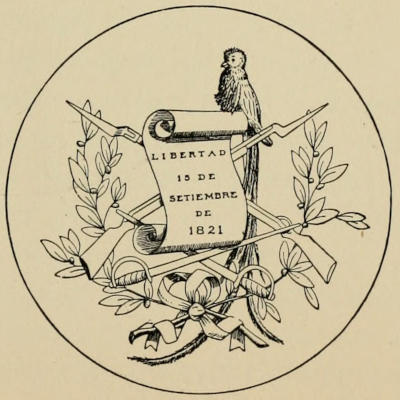GUATEMALA
THE LAND OF THE QUETZAL

MONOLITH ‘A’ AT QUIRIGUA.
GUATEMALA
THE LAND OF THE QUETZAL
A Sketch
By WILLIAM T. BRIGHAM, A.M.

NEW YORK
CHARLES SCRIBNER’S SONS
1887
Copyright, 1887,
By William T. Brigham.
UNIVERSITY PRESS:
John Wilson and Son, Cambridge.

A belief in the increasing importance of CentralAmerica, both geographically and politically, hasled the writer of the following pages to collect for hisown use and print for the use of others, notes madeduring three journeys in Guatemala and Honduras. Hedoes not pretend to offer a monograph on Guatemala, norto add to the general knowledge of Central America; butremembering the lack of guidance from which he sufferedin travelling through the country, would in some measuresave others from the same inconvenience. He seeks also,with perhaps more ambition, to awaken among Americansgreater interest in the much-neglected regions betweenthe Republic of Mexico and the Isthmus of Darien.
A land which was the cradle of civilization on thiscontinent, and whose recently explored monuments aremost justly claiming the study and admiration of archæologistsin Europe as well as in America, has beenstrangely neglected by the American traveller as well asby the American merchant. Since the Travels of Stephensfascinated the public nearly half a century ago, the peopleof the United States have paid very little attention toGuatemala or its commerce. Even now there are thousandsof square miles of wholly unexplored territorybetween the low Isthmus of Tehuantepec and the Lake ofNicaragua.
No country on the northern half of the Americancontinent has a finer climate or more beautiful and variedscenery, or is a more attractive field for the genuinetraveller. Valleys rivalling the paradises of the islandsof the Pacific; uplands not unlike the plateau of theIndian Neilgherries; forests as dense and luxuriant asthose of Brazil; lakes as picturesque as those of Switzerland;green slopes that might have been taken from theEmerald Isle; glens like the Trossachs; desert wastesthat recall the Sahara; volcanoes like Ætna; and apopulation as various as in that land whence comes theIndian name,—all these features make but the incompleteou